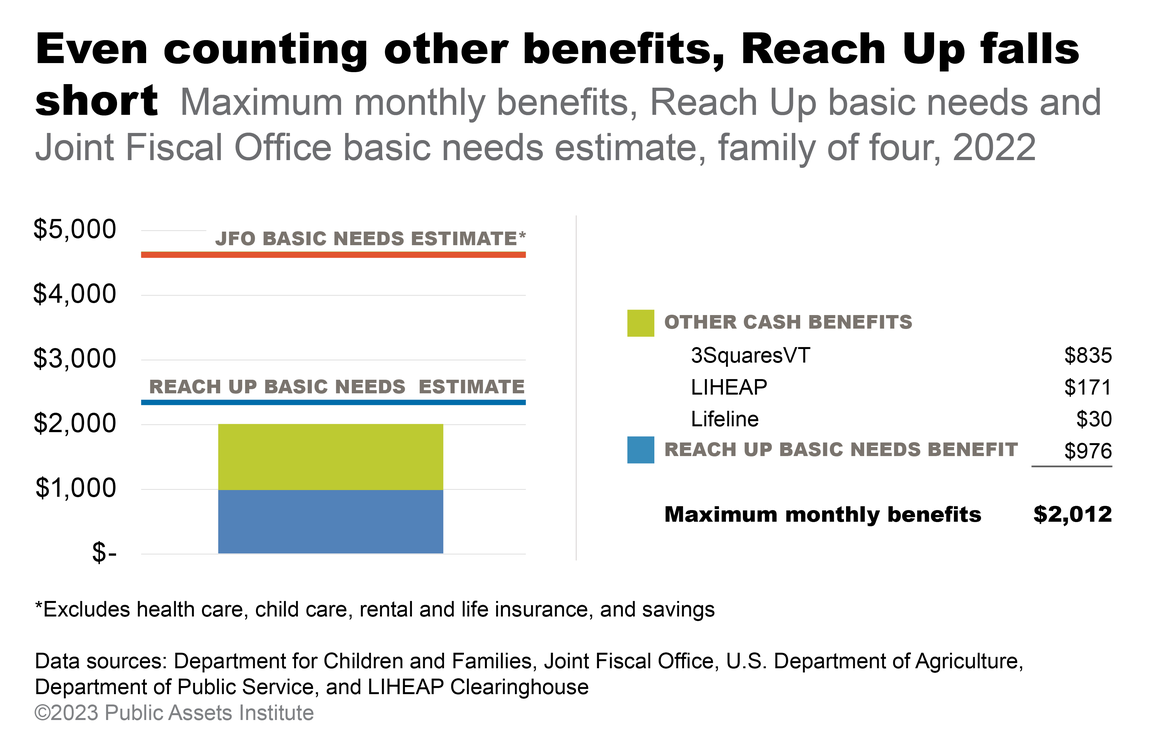Reach Up(Date) 2024: Real Change For Children Experiencing Extreme Poverty
Child poverty is a policy choice. At Voices, we work to transform systems that perpetuate child poverty and direct state resources to where they can have the greatest impact. Income support programs like Reach Up can be powerful anti-poverty tools, but if they are not adequately funded, they can hold families in poverty, which we know is harmful to children. While the legislature made important progress in 2022, we have so much more work to do. With your support, there is a chance this year to take a significant step toward ensuring children’s minimum needs are met— we’re talking food, clothing, and a safe place to live— basic necessities that every child deserves.
Reach Up is difficult to explain and even more difficult to navigate. As a result, the level of extreme deprivation perpetuated by its underfunding frequently remains obscured. This update is intended to support champions like you in seeing through these complex systems in order to better understand the daily reality of families in Vermont, and we hope you’ll take a few minutes to join us. We promise it’s worth your time!
H.93 + H.94: Two chances for reform
Reach Up, Vermont’s TANF (Temporary Assistance for Needy Families) program, is designed to provide cash assistance to ensure that children’s basic needs are met. Money is distributed in the form of base grants that are provided to families each month. How much money is supplied by these base grants is dependent on our state’s budget, which begins with the Governor. This session, there were two bills introduced in the House attempting to create structural changes to improve the process, H.93 and H.94. H.93 would have created a new standard for determining the basic need stipend and the housing allowance for Reach Up. Unfortunately, this bill did not make the cross-over deadline. As a result, Vermont will continue with its current practice of using a2 019 estimation of basic needs and a housing allowance that was last updated in 2001 (yes, that’s right—2001, not 2021) to determine the amount that families receive.
The second opportunity for reform presented by the legislature, H.94, is a short and simple bill that directs the administration to come up with a plan to eliminate the ratable reduction over the next 5 years. The ratable reduction deeply restricts how much money families receive each month, and such a change would have a huge impact on the wellbeing of children experiencing extreme poverty. This bill was introduced and passed by the House and is currently being reviewed by the Senate Committee on Health and Welfare. If H.94 passes, Vermont can change the deprivation level associated with deep poverty by taking a definitive step toward providing adequate Reach Up grants and housing assistance.
Why it matters: How the ratable reduction hurts families
Reach Up is mandated to improve the well-being of children by ensuring their basic needs are met, including food, housing, and clothing. But our state consistently fails to meet that mandate, leaving families unable to provide for these needs. In order to understand how this happens, it’s worth taking a look at the process.
Each year, the administration predicts how many families will qualify for Reach Up, aka the “caseload.” Rather than determining how much families need to get by and working forward from there, this caseload number is instead applied to a series of equations that determine how much a family will get. The rationale for this is that it prevents the state from overspending, however, in our research, we have yet to discover this sort of equation applied anywhere in the budget other than to children and families in extreme poverty.
This year, for example, the administration began with an outdated (ie the 2001 and 2019 numbers listed above) estimation of costs to create a basic needs budget for 2024. They then apply what is called the “ratable reduction” to that number, essentially cutting it in half. You read that right— in a program mandated to cover kids basic needs, we take the amount those basic needs cost years prior and cut it in half. That reduced, fully outdated figure from 2019 & 2001 then becomes the proposed maximum benefit for the year. We know that the actual benefit is often reduced even further for things like child support and income. More math is used to multiply the projected caseloads with the agreed-upon grant. This figure is then sent to the legislature as the Reach Up line in the proposed 2024 budget. As you can imagine, this leaves families in extreme poverty and unable to account for even basic necessities.
Weaponizing caseload sizes
One of the major considerations around increasing Reach Up base grants is caseload size. Because the amount of the grant determines how many families qualify to receive it, conversations around Reach Up frequently focus on the importance of “caseload reduction.” Caseloads can be reduced in one of two ways— by making the program increasingly inaccessible and lowering the benefit, or because there are fewer people in need of basic needs support. According a report from the Center on Budget and Policy Priorities cited by the Public Assets Institute, the share of families in poverty receiving assistance dropped from 80% to 55% between 1996 and 2017. This matters, because when we hold up caseload reduction as the ultimate goal, increasing numbers of families and children experience extreme deprivation. People are only eligible for Reach Up if they make less than the current grant, which does not come close to meeting basic needs. This means many families who cannot provide for basic needs are left out in the cold.
While H. 94 will increase caseloads, based on DCF’s testimony, a family of three currently has a maximum grant of $735/month, or $8,820/year. If the grant doubled, then families of three would be eligible only if they were making less than $17,640 per year. Furthermore, because income counts against the grants, families at the higher end of this income bracket would be getting a significantly reduced benefit. Taking a moment to consider how far $17,640 would go in meeting your family’s needs is a worthwhile exercise. Qualifying families with children who make less than this for cash assistance is a bare minimum step toward supporting child well-being.
What happens when we underfund Reach Up?
Even in combination with other cash benefits, Reach Up is not enough to meet families’ basic needs. We have asked parents the obvious question “How do you make the Reach Up budget work?” Most prioritize bills based on what utility might be turned off first. They forgo all “unnecessary” expenses, like eyeglasses. Those who have the privilege of credit, take on debt that takes decades to pay back. Poverty is expensive. It is also a direct result of the policy choices we make as a state.
Poverty is also linked to increased rates of domestic violence. According to the US Department of Health and Human Services, thirty-eight percent of all domestic violence victims become homeless at some point in their lives. We frequently hear stories from parents experiencing domestic violence or abuse who are forced to weigh which terrible option is best for their kids. If they leave and don't have the capacity to meet basic needs, they fear (rightfully) that the court will take their children and may grant custody to the unsafe parent. They also worry about the unknown dangers of emergency housing options. Adequately funded cash assistance programs give people space to make the decisions that prioritize their own best interests and the health and safety of their children.
When we don’t adequately fund Reach Up, the demand for other services also rises. This creates a burden on the families (who are required to know who to contact to meet each specific need, must self-identify poverty repetitively, and are forced to invest an unacceptable amount of time filling out multiple applications) and it transfers the state’s responsibility to under-resourced community organizations. The result is that community and provider networks such as diaper banks, food pantries, principal funds at schools, Parent Child Center special funds, toy drives, coat drives, boot drives, car seat programs, and more are stretched beyond capacity. The burden they carry to account for our lack of investment is unsustainable.
Long-term consequences
The majority of Reach Up families will already be losing $95/month beginning this month, due to the SNAP emergency allotment loss. If we fail to shift towards stability, we can predict that about half of the children who are on Reach Up today will receive benefits as adult participants. We know that persistent poverty is harmful to kids, and parenting in poverty creates a level of stress that is untenable. Adults often call child protective services when barriers to safe housing, adequate food, transportation to healthcare, and more start showing up in children’s behaviors. While kids are not taken into state care due to poverty alone, we know that the symptoms of poverty create understandable concern and therefore, kids who are living in poverty are much more likely to come into state custody. We hear about kids being restrained in foster homes, switching placements at alarming rates, and quickly ending up without placement options.
We need to do better
In times of crisis, we often speak of our belief in the resilience of children. But leaning on children’s ability to endure the untenable should not be our primary strategy. Meeting basic needs is the first step to addressing persistent poverty.
Vermont is in a position to create a system that works for children, youth, and families. Every year, we make conscious decisions about how we choose to invest many of our TANF (Temporary Assistance for Needy Families) dollars and why. Today we are asking the legislature to center the health and well-being of the children and families in updating this structure to center meeting basic needs.
Supporting structural change
There are many opportunities to support structural changes to our Reach Up program. Some of these include:
The legislature can…
Pass H.94 and look for opportunities to sunset the ratable reduction ASAP. This will show a commitment to meeting the program’s goals and statutory purpose. It will be critical to ensure that the report created is implemented with the urgency that it deserves.
Fully fund Reach Up in the 2024 budget. In addition to the financial opportunities, the structural changes that can be made with new language within the budget should not be understated. Committing to using updated figures to determine cash assistance would set this program up for success.
Fund the Reach Ahead pilot and look for other innovative ways to get cash to families.
The Administration can…
Support the program by agreeing to fully fund Reach Up in the budget.
We can all..
Take time to listen and inform our communities about the lived experience of families and children facing extreme poverty.
Celebrate programs that support families.
Look for opportunities to ensure that those with power know the importance of cash assistance.
Next steps for Champions like you!
Reach Up is currently on the calendar (Senate Health and Welfare) for Friday the 28th. Now is the time to let your Senators know that you support this bill! Please take 2 minutes today to contact your Senator and let them know we must prioritize the basic needs of the children and families who rely on Reach Up to support their health and wellbeing by passing H.94 and eliminating the harmful Ratable Reduction.
Find your legislator here, then call the Statehouse at 802-828-2228 and leave a message!
Thank you for supporting Vermont’s Children and Families!





